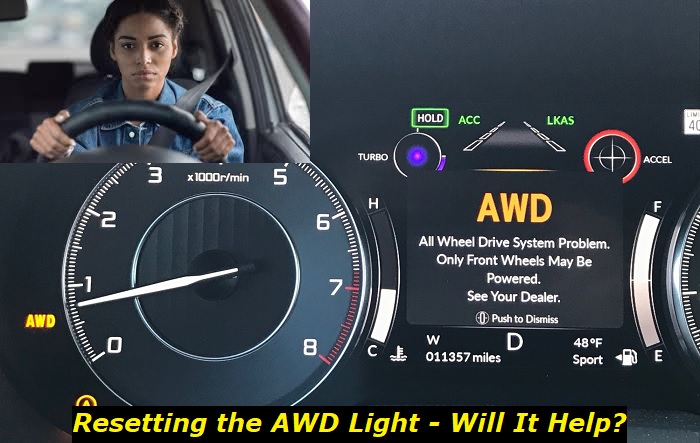The all-wheel drive (AWD) system of your car or truck handles the power distribution on all four wheels to improve traction and stability. But just like every other vehicle system, the AWD is prone to faults and its warning light may come on to indicate such an occurrence.
AWD light highlights
- Common reasons:4WD or AWD problems, software glitch
- How to fix:try disconnecting the battery for some time, have the car inspected
- Possible consequences:all-wheel-drive units can die
- Priority level:High
- Can you drive?Not recommended
- DIY repair:Impossible
- Repair price range:$400-$1,500

Seeing the All-Wheel Drive Light Coming On
As stated earlier, you should be suspicious that there's a fault in the AWD system of your car if its warning or service light illuminates. So you have to quickly take some steps to diagnose the problem and fix it to ensure safety when driving. You might even be seeing some uncomfortable symptoms while driving already.
Ascertain the system's problem by conducting physical and software checks using special equipment. For example, employing a scan tool to see if error codes will come up. These are best done with the help of a hired mechanic. The indicator light should go off after all the necessary fixes or resets have been done.
Why the All-Wheel Drive Warning Light May Be Illuminating on the Dashboard
The following are six reasons that trigger the AWD light to illuminate on the dash of your car or truck:
1) Sensor Damage or Malfunction
The AWD system mainly deals with the wheels of the vehicle with the aid of sensors. These sensors detect the traction, speed, rotation per cycle, and so on of the wheels. So the light may come on when one or more of these sensors send incorrect data or can't relay signals.
2) Failing Mechanical Part
A faulty mechanical component could be the reason for seeing the AWD dash light. For example; a defective driveshaft, differential, or transfer case.
It could be a result of a leak or damage in such parts. Keep in mind that the possibility of an engine issue triggering the indicator light to turn on is a rare occurrence.
3) Low Fluid Levels
The AWD system in recent model-year vehicles uses various system fluids in places like the transfer case and differential. It will be seen as a problem by your car's computer if the quantities of such fluids are too low.
The fluids are necessary for the lubrication and cooling off of such areas or parts. You'll have to look out for fluid leaks as well.
4) Problems with Electrical Components
Electrical parts like wires and other related components could start malfunctioning as a result of shorting, loose connections, etc. This will hinder the AWD system from working perfectly and communicating with the sensors completely or effectively. There may be no interaction with the sensors at all!
This is one of the complicated checks and repairs that you can't compromise on when trying to diagnose them. You just have to leave it to an expert because of how demanding or tedious things may get.
5) ECU Issue or Software Malfunction
Recent model-year cars feature many control units with huge sizes of software. These CUs regulate vehicle systems and features. So there'll be problems when these control units are defective or damaged. That includes the need to clear software errors or update the package.
The same goes for the ECU and its software. And your car's AWD could be the one that's adversely affected. Its light could start flashing to alert you. Low fuel levels, overheating, or power surges can also lead to ECU faults, but keep in mind that such cases are very rare.
6) Environmental Factors
This may seem highly unlikely but factors like temperature can trigger the AWD light to illuminate or start flashing Very hot or cold weather can make the sensors malfunction or mess up the wire connection.
For example, some components are susceptible to getting frozen and breaking during winter, while others may be too stiff to move. Fluids in the system may also get frozen. Nonetheless, the chances of this happening are low because such fluids are made with chemicals that are freeze-resistant.
Checking and Fixing AWD System Issues Then Resetting Its System/Warning Light
As mentioned earlier, figuring out the reason for the AWD light coming on can involve a series of complex processes. Fortunately, you may have enough practical knowledge to do some checks DIY style. Use the AWD inspection tips here in such a case.
1) Sensor Repair or Replacement
The issue of damaged sensors can only be resolved by swapping them out. You can't repair such parts only to reuse them. They'll end up getting bad in a short time, even if it's somehow possible to fix and reuse them. It's a bad investment but you may do so as a temporary solution.
However, ensure that you check for obstacles that may be hindering the sensors from performing their duties before changing them. Don't just jump to the conclusion that an unresponsive sensor is dead.
It could be debris, dirt, or dust that's the culprit. Such things can gather at a crucial spot and block the area that the sensors are meant to monitor. So clean the area and test the working condition of the affected sensor again.
2) Fixing or Swapping Out Bad Mechanical Parts
You may be able to repair or replace the affected mechanical component, based on the type or level of damage. If the part isn't repairable, it means that there's a need to swap it out. Whatever the case may be, the AWD light should stop coming on once the solution has been implemented.
3) Refilling or Topping Up Fluids That Are Important To the AWD System
Check all the reservoirs that hold the fluids and top their levels up if necessary. You may even encounter an empty tank among them. And that will be a sign that you aren't checking the reservoirs regularly.
Remember that we mentioned low fuel levels as a possible trigger for an ECU-AWD fault? So the first place you should check is the gas meter or fuel gauge on the dashboard or instrument cluster of your car.
Some other fluid levels can't be read that easily unless you perform checks on their reservoir. Get ready to make your hands dirty for this job or avoid the hassle with a hired professional hand. Although using safety (rubber) gloves is advisable instead of your bare hands.
Locate the other reservoirs by making reference to the vehicle owner's manual. You won't only be checking for the fluid levels but also signs of leaking fluid. Look for all the leakages and get them patched up or repaired. One or more components may have to be replaced or tightened.
Keep in mind that leaks will deplete fluids quickly. Hence you can be sure that there's a leak if it hasn't been long since the last refill or if the timing of the low level is abnormal. Lastly, ensure that the reservoirs are filled up following their recommended fluid limits.
4) Inspecting the Electrical Components or Wiring
We've already stated the best way to go about this-leaving it to a pro. But be ready to check all the computers, electronics, connectors, and cables that are linked to the AWD system if you can handle this aspect of the series of diagnoses on your own. And if you have to replace something, then do so to get rid of the AWD light.
However, brace yourself for an expensive swap and the unavoidable step of taking the car to an auto repair shop for any complex fix. You could even complicate issues or mess up the wiring during a physical DIY check. That will mean more problems and more expenses!
So we don't advise that you risk a DIY check. Stay away from such a process if your expertise or experience with the vehicle's electrical components isn't enough!
The technicians will be looking for signs of shorting, looseness, burning, corrosion, rusting, disconnection, etc. They will likely hook up a scanner to the car for OBD2 diagnostics to take place and read error codes.
You can check for the codes before taking the vehicle to an auto repair shop if you have a code reader. The error codes will help in tracing the source of the AWD fault and making things cheap at the repairer's workshop.
5) ECU or Software Restart/Reset/Update
Reset or restart the ECU or vehicle's computer if you can see that the AWD light is on because of it. There may be a need to update the software or replace the ECU if it's damaged.
Conclusion
Always ensure that you disconnect your car's battery when performing a physical DIY electrical part check. This is to prevent the possibility of electrical damage. Be willing to give up and stop the check once you get to a point where you know you can't progress. It could be due to inadequate technical know-how.
About the authors
The CarAraC research team is composed of seasoned auto mechanics and automotive industry professionals, including individuals with advanced degrees and certifications in their field. Our team members boast prestigious credentials, reflecting their extensive knowledge and skills. These qualifications include: IMI: Institute of the Motor Industry, ASE-Certified Master Automobile Technicians; Coventry University, Graduate of MA in Automotive Journalism; Politecnico di Torino, Italy, MS Automotive Engineering; Ss. Cyril and Methodius University in Skopje, Mechanical University in Skopje; TOC Automotive College; DHA Suffa University, Department of Mechanical Engineering






Add comment